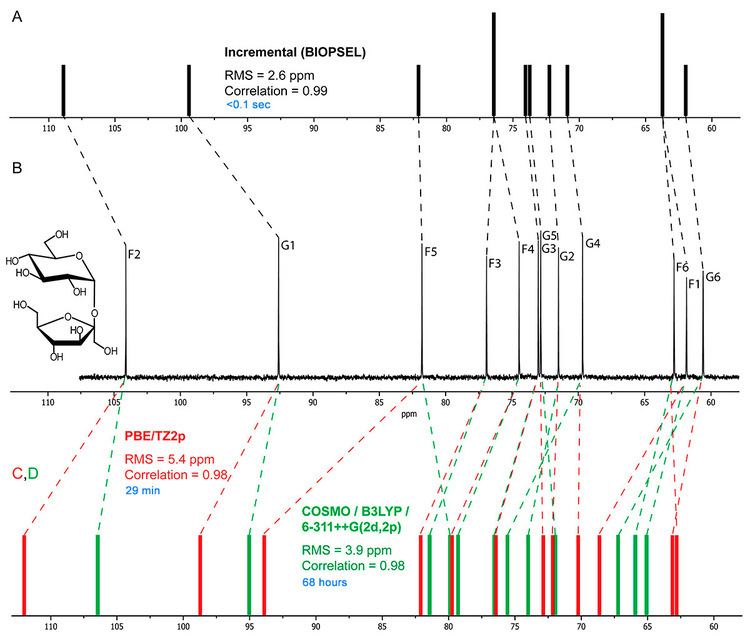 | ||
Carbohydrate NMR Spectroscopy is the application of nuclear magnetic resonance (NMR) spectroscopy to structural and conformational analysis of carbohydrates. This method allows the scientists to elucidate structure of monosaccharides, oligosaccharides, polysaccharides, glycoconjugates and other carbohydrate derivatives from synthetic and natural sources. Among structural properties that could be determined by NMR are primary structure (including stereochemistry), saccharide conformation, stoichiometry of substituents, and ratio of individual saccharides in a mixture. Modern high field NMR instruments used for carbohydrate samples, typically 500 MHz or higher, are able to run a suite of 1D, 2D, and 3D experiments to determine a structure of carbohydrate compounds.
Contents
- Chemical shift
- Coupling constants
- Nuclear Overhauser effects NOEs
- Other NMR observables
- Structural parameters of carbohydrates
- NMR spectroscopy vs other methods
- Application of various NMR techniques to carbohydrates
- Research scheme
- Carbohydrate NMR databases and tools
- Simulation of the NMR observables
- References
Chemical shift
Common chemical shift ranges for nuclei within carbohydrate residues are:
In the case of simple mono- and oligosaccharide molecules, all proton signals are typically separated from one another (usually at 500 MHz or better NMR instruments) and can be assigned using 1D NMR spectrum only. However, bigger molecules exhibit significant proton signal overlap, especially in the non-anomeric region (3-4 ppm). Carbon-13 NMR overcomes this disadvantage by larger range of chemical shifts and special techniques allowing to block carbon-proton spin coupling, thus making all carbon signals high and narrow singlets distinguishable from each other.
The typical ranges of specific carbohydrate carbon chemical shifts in the unsubstituted monosaccharides are:
Coupling constants
Direct carbon-proton coupling constants are used to study the anomeric configuration of a sugar. Vicinal proton-proton coupling constants are used to study stereo orientation of protons relatively to the other protons within a sugar ring, thus identifying a monosaccharide. Vicinal heteronuclear H-C-O-C coupling constants are used to study torsional angles along glycosidic bond between sugars or along exocyclic fragments, thus revealing a molecular conformation.
Sugar rings are relatevely rigid molecular fragments, thus vicinal proton-proton couplings are characteristic:
Nuclear Overhauser effects (NOEs)
NOEs are sensitive to interatomic distances, allowing their usage as a conformational probe, or proof of a glycoside bond formation. It's a common practice to compare calculated to experimental proton-proton NOEs in oligosaccharides to confirm a theoretical conformational map. Calculation of NOEs implies an optimization of molecular geometry.
Other NMR observables
Relaxivities, nuclear relaxation rates, line shape and other parameters were reported useful in structural studies of carbohydrates.
Structural parameters of carbohydrates
The following is a list of structural features that can be elucidated by NMR:
NMR spectroscopy vs. other methods
Wide known methods of structural investigation, such as mass-spectrometry and X-ray analysis are only limitedly applicable to carbohydrates. Such structural studies, such as sequence determination or identification of new monosaccharides, benefit the most from the NMR spectroscopy. Absolute configuration and polymerization degree are not always determinable using NMR only, so the process of structural elucidation may require additional methods. Although monomeric composition can be solved by NMR, chromatographic and mass-spectroscopic methods provide this information sometimes easier. The other structural features listed above can be determined solely by the NMR spectroscopic methods. The limitation of the NMR structural studies of carbophydrates is that structure elucidation can hardly be automatized and require a human expert to derive a structure from NMR spectra.
Application of various NMR techniques to carbohydrates
Complex glycans possess a multitude of overlapping signals, especially in a proton spectrum. Therefore, it is advantageous to utilize 2D experiments for the assignment of signals. The table and figures below list most widespread NMR techniques used in carbohydrate studies.
Research scheme
NMR spectroscopic research includes the following steps:
Carbohydrate NMR databases and tools
Multiple chemical shift databases and related services have been created to aid structural elucidation of and expert analysis of their NMR spectra. Of them, several informatics tools are dedicated solely to carbohydrates:
Simulation of the NMR observables
Several approaches to simulate NMR observables of carbohydrates has been reviewed. They include:
Growing computational power allows usage of thorough quantum-mechanical calculations at high theory levels and large basis sets for refining the molecular geometry of carbohydrates and subsequent prediction of NMR observables using GIAO and other methods with or without solvent effect account. Among combinations of theory level and a basis set reported as sufficient for NMR predictions were B3LYP/6-311G++(2d,2p) and PBE/PBE (see review). It was shown for saccharides that carbohydrate-optimized empirical schemes provide significantly better accuracy (0.0-0.5 ppm per 13C resonance) than quantum chemical methods (above 2.0 ppm per resonance) reported as best for NMR simulations, and work thousands times faster. However, these methods can predict only chemical shifts and perform poor for non-carbohydrate parts of molecules. As a representative example, see figure on the right.
